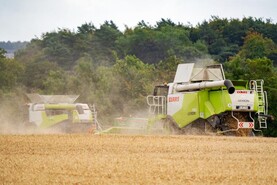Concerns remain that a potential beef “spike” in Europe could depress cattle prices.
Trevor Donnellan, economist with Teagasc, warned that the impact of COVID-19 had meant that farmers on the continent had not sent cattle for slaughter as expected and that those cattle still remained on-farm and would need to be killed at some stage.
At the moment, things seem to be working out even slightly better than our best-case scenario earlier in the year
However, he told the Irish Farmers Journal that Teagasc remained “cautiously optimistic” that the impact of COVID-19 would not be as severe on Irish farm incomes as had been first predicted.
“At the moment, things seem to be working out even slightly better than our best-case scenario earlier in the year but it could get pushed back if there is a second wave and whether that will happen or not we don’t know,” Donnellan said.
He said a virus outbreak in the UK and Europe could still affect Irish trade and pointed out that the UK, in particular, was Ireland’s most important market.
“In the short-term, dairy has dodged the bullet in terms of the bigger risks associated with COVID-19,” he said.
Sectors have benefitted in reduced feeds bills thanks to more normalised weather and lower fertiliser costs
Overall, Teagasc predicts average dairy incomes will be roughly the same as last year at about €67,000.
Government supports will boost average suckler incomes by 5% to €9,700, while sheep farmers could see a 15% rise to €17,000 for 2020.
Sectors have benefitted in reduced feeds bills thanks to more normalised weather and lower fertiliser costs.
Other sectors also face challenges with cattle finishers facing a 4% drop in their income down to an average of €13,300.
The most dire warning in the Teagasc prediction comes for tillage farmer. It said the average tillage farmer will still struggle to make €30,000 in 2020.
Read more
Beef management: housing autumn-born bulls for intensive finishing
Prices up to €3.65/kg in Elphin Mart
Concerns remain that a potential beef “spike” in Europe could depress cattle prices.
Trevor Donnellan, economist with Teagasc, warned that the impact of COVID-19 had meant that farmers on the continent had not sent cattle for slaughter as expected and that those cattle still remained on-farm and would need to be killed at some stage.
At the moment, things seem to be working out even slightly better than our best-case scenario earlier in the year
However, he told the Irish Farmers Journal that Teagasc remained “cautiously optimistic” that the impact of COVID-19 would not be as severe on Irish farm incomes as had been first predicted.
“At the moment, things seem to be working out even slightly better than our best-case scenario earlier in the year but it could get pushed back if there is a second wave and whether that will happen or not we don’t know,” Donnellan said.
He said a virus outbreak in the UK and Europe could still affect Irish trade and pointed out that the UK, in particular, was Ireland’s most important market.
“In the short-term, dairy has dodged the bullet in terms of the bigger risks associated with COVID-19,” he said.
Sectors have benefitted in reduced feeds bills thanks to more normalised weather and lower fertiliser costs
Overall, Teagasc predicts average dairy incomes will be roughly the same as last year at about €67,000.
Government supports will boost average suckler incomes by 5% to €9,700, while sheep farmers could see a 15% rise to €17,000 for 2020.
Sectors have benefitted in reduced feeds bills thanks to more normalised weather and lower fertiliser costs.
Other sectors also face challenges with cattle finishers facing a 4% drop in their income down to an average of €13,300.
The most dire warning in the Teagasc prediction comes for tillage farmer. It said the average tillage farmer will still struggle to make €30,000 in 2020.
Read more
Beef management: housing autumn-born bulls for intensive finishing
Prices up to €3.65/kg in Elphin Mart






 This is a subscriber-only article
This is a subscriber-only article










SHARING OPTIONS: